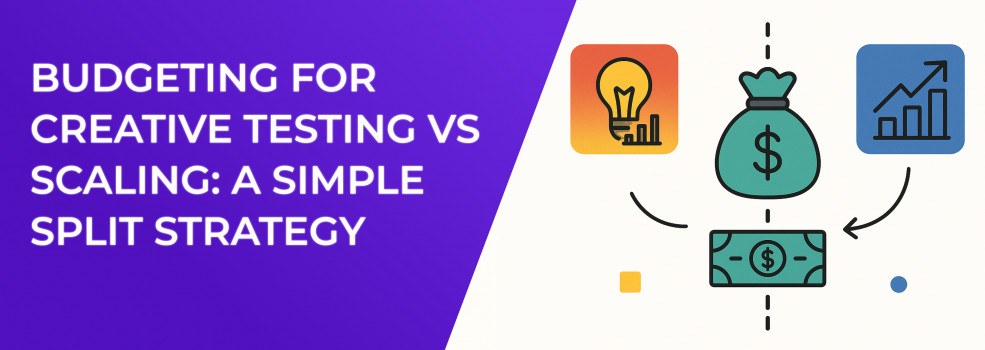Balancing exploration and exploitation is one of the great puzzles of paid social. If you pour every cent into new ideas, you risk never giving your strongest ads the runway they deserve. If you do the opposite and squeeze established winners for too long, creative fatigue creeps in and Facebook ad performance starts to slip. If you’re already worried about that fatigue kicking in, check out Ad Fatigue on Facebook: How to Spot It Early and Fix It Fast for early warning signs and quick fixes.
The sections below outline a straightforward framework that lets you fund both creative testing and scaling without second-guessing yourself.
Why Your Budget Split Matters
A healthy budget split protects you from two common traps. First, Facebook’s auction system rewards relevance. Once an ad’s frequency climbs, users scroll past it, and CTR Facebook drops. Second, pausing testing altogether leaves you scrambling the next time performance tanks. A simple, intentional division of spend ensures that:
-
Creative Testing finds tomorrow’s winning concepts.
-
Scaling maximizes today’s proven assets.
Before getting into exact percentages, think through audience size, funnel stage, and campaign budget optimization settings. Those factors affect how flexibly you can move money week to week. Facebook often shows the “ad set may get zero” warning when budgets are mis‑allocated, so keep this explainer on what it means and how to solve it handy.
The 60/40 Rule of Thumb
Many advertisers ask for a single benchmark. In practice, a 60 percent scale budget and 40 percent test budget covers most scenarios. Monthly ad spend and data speed can nudge those figures up or down.
When budgets are tiny, data accumulates slowly. You must allocate more to testing to locate creative angles that eventually justify scale. As spend rises, you gather statistically significant results faster, allowing a stronger emphasis on scaling without starving the test pipeline.
Unsure what a “good” CTR looks like today? Here are the latest CTR benchmarks for Facebook Ads. Immediately after reviewing your own numbers, write down the assumptions you used: target CPA, typical Facebook ads conversion rate, seasonality. Revisiting those notes each month makes it easier to decide whether the split still fits your goals.
Setting Up Campaigns for a Smooth Split
The biggest operational mistake is scattering experiments inside scaling campaigns. Treat testing like a mini laboratory with clear walls around it. Follow this checklist:
-
Group fresh assets in one “Creative Lab.” A single Advantage Campaign Budget (or classic CBO campaign) handles campaign budget optimization so outliers cannot consume the entire test budget.
-
Define exit criteria before launch. If CPM rises 30 percent above your account average for three consecutive days, pause the ad. If Facebook ad CTR average stays below baseline, cut it. Clear thresholds remove emotion from decision-making.
-
Promote winners quickly. Duplicate a successful ad into the scaling campaign, keep the original ad ID to preserve social proof, and let it progress without a full learning reset.
Moving winners without resetting learning is easier when you follow the tips in How to Finish the Facebook Learning Phase Quickly.
After completing those steps, spend five minutes documenting why each creative passed or failed. That qualitative note beside the raw Facebook ad metrics will help when you brief your design team next month.
Metrics to Watch Closely
Data tells you when to shift budget between testing and scaling. These five metrics give most of the signal you need.
In creative testing, curiosity outweighs efficiency. You want to know if a concept can reach baseline engagement. Once an ad moves to scaling, raw efficiency, especially ROAS benchmarks, becomes the priority.
For a deeper dive into reading those numbers, skim How to Analyze Facebook Ad Performance Beyond CTR and CPC next.
Review the full picture before acting. A mildly lower CTR paired with a strong lift in conversion rate can still be a net win.
Troubleshooting Common Budget-Split Issues
Even the best framework hits roadblocks. Reading the scenarios below now will keep you from overreacting later.
High spend, low learning
CPM jumps, Facebook ad optimization stalls. Cut test budget to 20 percent, merge overlapping ad sets, and broaden audience size. If conversions have stalled entirely, Facebook Ads Not Converting: How To Fix It lays out a step‑by‑step rescue plan.Great tests, weak scale
A creative thrives in the lab but craters when promoted. Duplicate it into a new Meta ads campaign with identical settings rather than dropping it into an old scaling campaign.Fast creative burnout
Facebook ad CTR plummets by day seven. Shorten the creative cycle and queue fresh concepts so the lab never sits empty.Automating the Split
As daily spend grows, manual budget swaps become tedious. Built-in rules simplify workflow:
Automated budget rules can pause any creative whose CPA exceeds target for three days.
Advantage+ Creative mixes headlines and images to extend asset lifespan.
Dynamic audience refresh keeps look-alike quality strong so scaling campaigns never stagnate.
Run a sandbox test first at minimal budget to catch naming errors or conflicting conditions that might zero out spend unexpectedly. You can go even further with rule‑based workflows by following the playbook in How to Use Automated Rules to Improve Facebook Campaign Efficiency.
Putting It All Together
Start by writing your revenue goal for the month and pick a target CPA or ROAS that supports it. Apply the 60/40 framework, then place new ads inside the Creative Lab. Monitor CTR Facebook, CPC, and conversion rate daily during the first week, promote winners promptly, and feed the lab with fresh concepts every Monday. Over time, the rhythm becomes second nature and Facebook advertising best practices turn into habits instead of rescue missions.
Final Thought
You never have to choose between predictable profits and innovative storytelling. A clear budget split, well-defined metrics, and consistent processes allow you to pursue both. Once that system is humming, Facebook ads tips become incremental gains, and your campaigns stay resilient even when platform trends shift.

